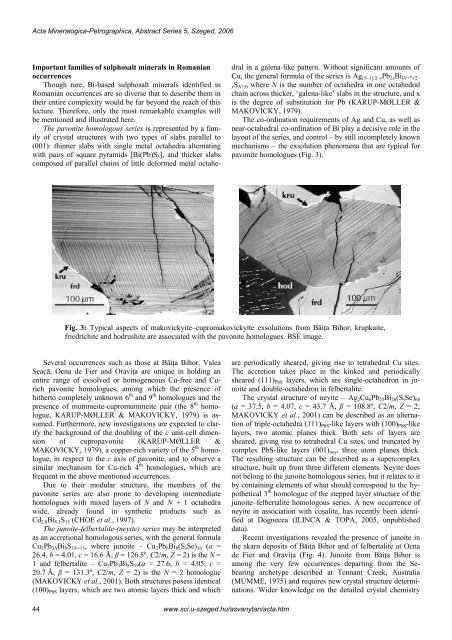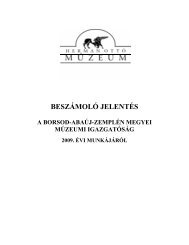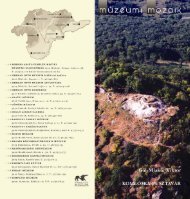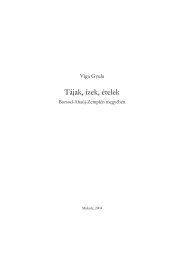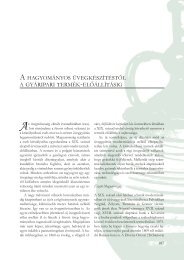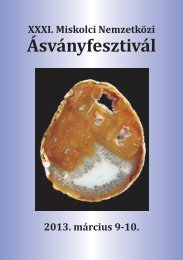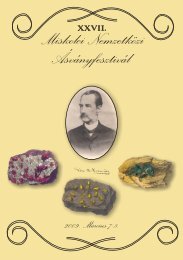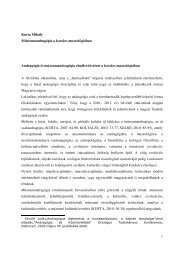MSCC3 3rd MINERAL SCIENCES IN THE CARPATHIANS ...
MSCC3 3rd MINERAL SCIENCES IN THE CARPATHIANS ...
MSCC3 3rd MINERAL SCIENCES IN THE CARPATHIANS ...
You also want an ePaper? Increase the reach of your titles
YUMPU automatically turns print PDFs into web optimized ePapers that Google loves.
Acta Mineralogica-Petrographica, Abstract Series 5, Szeged, 2006Important families of sulphosalt minerals in RomanianoccurrencesThough rare, Bi-based sulphosalt minerals identified inRomanian occurrences are so diverse that to describe them intheir entire complexity would be far beyond the reach of thislecture. Therefore, only the most remarkable examples willbe mentioned and illustrated here.The pavonite homologous series is represented by a familyof crystal structures with two types of slabs parallel to(001): thinner slabs with single metal octahedra alternatingwith pairs of square pyramids [Bi(Pb)S 5 ], and thicker slabscomposed of parallel chains of little deformed metal octahedralin a galena-like pattern. Without significant amounts ofCu, the general formula of the series is Ag (N–1)/2–x Pb 2x Bi (N+7)/2–xS N+5 , where N is the number of octahedra in one octahedralchain across thicker, ‘galena-like’ slabs in the structure, and xis the degree of substitution for Pb (KARUP-MØLLER &MAKOVICKY, 1979).The co-ordination requirements of Ag and Cu, as well asnear-octahedral co-ordination of Bi play a decisive role in thelayout of the series, and control – by still incompletely knownmechanisms – the exsolution phenomena that are typical forpavonite homologues (Fig. 3).Fig. 3: Typical aspects of makovickyite–cupromakovickyite exsolutions from Băiţa Bihor; krupkaite,friedrichite and hodrushite are associated with the pavonite homologues. BSE image.Several occurrences such as those at Băiţa Bihor, ValeaSeacă, Ocna de Fier and Oraviţa are unique in holding anentire range of exsolved or homogeneous Cu-free and Curichpavonite homologues, among which the presence ofhitherto completely unknown 6 th and 9 th homologues and thepresence of mummeite-cupromummeite pair (the 8 th homologue,KARUP-MØLLER & MAKOVICKY, 1979) is assumed.Furthermore, new investigations are expected to clarifythe background of the doubling of the c unit-cell dimensionof cupropavonite (KARUP-MØLLER &MAKOVICKY, 1979), a copper-rich variety of the 5 th homologue,in respect to the c axis of pavonite, and to observe asimilar mechanism for Cu-rich 4 th homologues, which arefrequent in the above mentioned occurrences.Due to their modular structure, the members of thepavonite series are also prone to developing intermediatehomologues with mixed layers of N and N + 1 octahedrawide, already found in synthetic products such asCd 2.8 Bi 8.1 S 15 (CHOE et al., 1997).The junoite-felbertalite-(neyite) series may be interpretedas an accretional homologous series, with the general formulaCu 2 Pb 3N Bi 8 S 3N+13 , where junoite – Cu 2 Pb 6 Bi 8 (S,Se) 16 (a =26.4, b = 4.01, c = 16.6 Å, β = 126.5º, C2/m, Z = 2) is the N =1 and felbertalite – Cu 2 Pb 3 Bi 8 S 19 (a = 27.6, b = 4.05, c =20.7 Å, β = 131.3º, C2/m, Z = 2) is the N = 2 homologue(MAKOVICKY et al., 2001). Both structures posess identical(100) PbS layers, which are two atomic layers thick and whichare periodically sheared, giving rise to tetrahedral Cu sites.The accretion takes place in the kinked and periodicallysheared (111) PbS layers, which are single-octahedron in junoiteand double-octahedron in felbertalite.The crystal structure of neyite – Ag 2 Cu 6 Pb 25 Bi 26 (S,Se) 68(a = 37.5, b = 4.07, c = 43.7 Å, β = 108.8º, C2/m, Z = 2;MAKOVICKY et al., 2001) can be described as an alternationof triple-octahedra (111) PbS -like layers with (100) PbS -likelayers, two atomic planes thick. Both sets of layers aresheared, giving rise to tetrahedral Cu sites, and truncated bycomplex PbS-like layers (001) ney , three atom planes thick.The resulting structure can be described as a supercomplexstructure, built up from three different elements. Neyite doesnot belong to the junoite homologous series, but it relates to itby containing elements of what should correspond to the hypothetical3 th homologue of the stepped layer structure of thejunoite–felbertalite homologous series. A new occurrence ofneyite in association with cosalite, has recently been identifiedat Dognecea (IL<strong>IN</strong>CA & TOPA, 2005, unpublisheddata).Recent investigations revealed the presence of junoite inthe skarn deposits of Băiţa Bihor and of felbertalite at Ocnade Fier and Oraviţa (Fig. 4). Junoite from Băiţa Bihor isamong the very few occurrences departing from the Sebearingarchetype described at Tennant Creek, Australia(MUMME, 1975) and requires new crystal structure determinations.Wider knowledge on the detailed crystal chemistry44www.sci.u-szeged.hu/asvanytan/acta.htm


